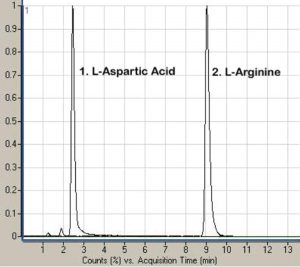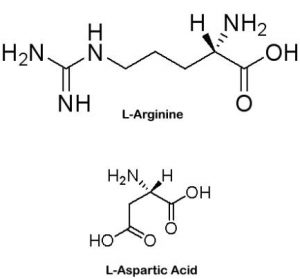Reduced Sample Prep and Handling
Two amino acids are adequately Retained and can be easily quantified in this Method with very little Sample Prep. There is no need for any Pre-Column or Post Column derivatizing due to Mass Spectrometric Detection can detect these molecules and Aqueous Normal Phase (ANP) HPLC can Retain in their ionized form as shown below. Also, this Method produces Reliable and Reproducible results.


Peaks:
1. L–Aspartic Acid, 134 m/z, RT = 2.45 minutes
2. L–Arginine, 175 m/z, RT = 9.05 minutes
Method Conditions
Column: Cogent Diamond Hydride™, 4μm, 100Å
Catalog No.: 70000-15P-2
Dimensions: 2.1 x 150mm
Mobile Phase: Isocratic 90:10 Solvent B / Solvent A
—A: DI Water / 0.1% Formic Acid
—B: Acetonitrile / 0.1% Formic Acid / 0.005% Trifluoroacetic Acid (TFA)
Flow rate: 400µL / minute
Detection: ESI – pos – Agilent 6210 MSD TOF Mass Spectrometer
Sample Preparation: 1mg / mL of each: L–Aspartic Acid / L-Arginine dissolved in 50:50 Acetonitrile / DI Water / 0.1 % Trifluoroacetic Acid (TFA)
—Sample for injection: Stock solution diluted 1:100 with the Mobile Phase
Notes: L-Arginine is classified as a semi essential or conditionally essential amino acid, that plays an important function in the metabolism of organisms. It is used to remove waste products (for example Ammonia) and to make other compounds (L–Proline, Creatine, cell signaling molecule: Nitric Oxide (NO) and L-Glutamate). The nitric compound made from L-Arginine relaxes blood vessels. The Aspartic Acid and Glutamic acid levels increase in the midbrain with Parkinon’s disease (PD) indicating participation of these amino acids in PD pathogenesis. The levels of these two amino acids are also relevant to other neurological diseases as Alzheimer disease (AD) and Schizophrenia. Therefore the determination of the changes of the two amino acids levels in biological samples is essential to research the pathogenesis of the above mentioned diseases as well as establishment of the treatment scheme.
Attachment
No 63 Aspartic Acid & Arginine Analyzed with LCMS pdf 0.2 Mb Download File


